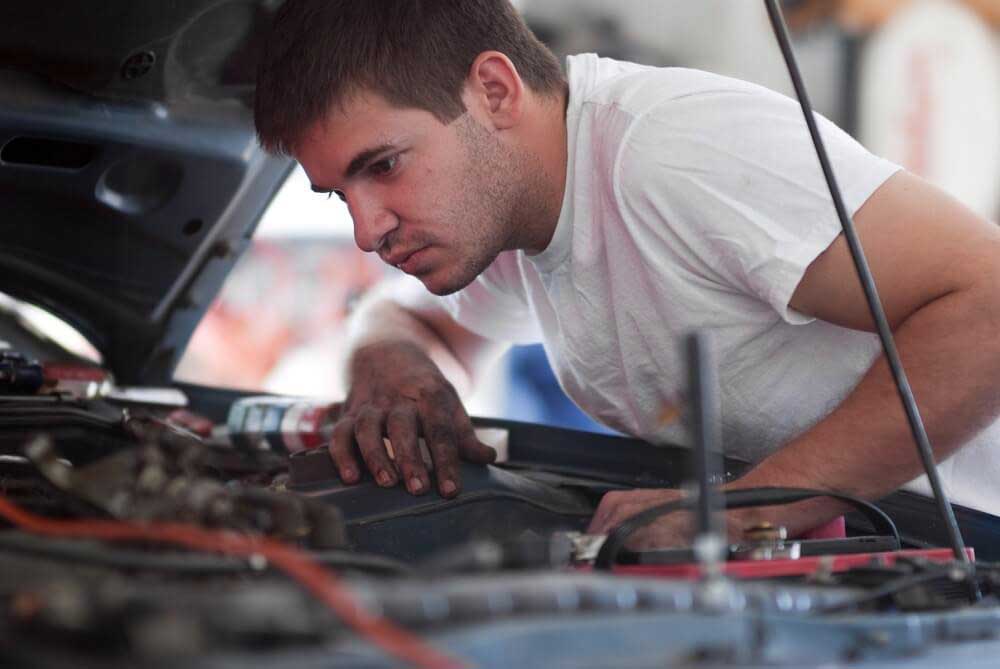DIY car checks you should do regularly
While cars require less maintenance these days, there are still a few checks required to ensure yours stays in good condition.

You don't need to be a mechanic to help make sure your car stays on the road.
A few simple checks will keep your vehicle running efficiently, without spending lots of money. You just need some basic tools and a little bit of time.
Check your air filter
You need a new air filter for your car about every 12 months or 20,000km, whichever comes first. They're easy to replace, just check your owner manual to find where it is in your car.
- First, find the filter under the hood of your car. It's in a black rectangular box with metal clips on the side.
- Open the casing, and check out how the air filter fits inside it. Make a note of which way the filter faces.
- Remove the old air filter, and insert the new one exactly how the old one sat.
- Remember to close the metal clips when you're done.
Change wiper blades
Wiper blades vary from car to car, so you may have to follow your owner's manual, but here are the basic steps:
- Lift the blades, as if you were washing your windshield by hand, and remove the old blades.
- Pay attention to how the old blades connect to the metal arms.
- On most models, you'll see a tab on the underside of the wiper. Push the tab to remove the old blade.
- Attach the new blades, being careful not to bend the wiper arms or scratch your windshield. Line everything up and make sure the new ones are secure and tight.
Swap spark plugs
Most spark plugs last longer than air filters or wiper blades, usually about 50,000km. You'll need to install them in a specific order.
- You'll find either four, six, or eight plugs, depending on how many cylinders in your car.
- Remove the wire to the first spark plug only. Do not remove all of the wires at once. Your spark plugs are installed in a certain order, which you need to maintain.
- Use your spark plug socket and extension on your ratchet to remove the first one.
- Install the new spark plug, screwing it in by hand first and then tightening it with a wrench for a snug fit. Remember not to over-tighten.
- Re-attach the spark plug wire.
- Follow these steps for each spark plug.
Battery maintenance
A simple visual check of the condition of your battery will tell you when it needs attention.
- Remove the battery terminals, which should be a fairly straightforward process. Make sure you always remove the negative cable first. If the terminals are stuck, use a flathead screwdriver to pry them loose.
- Use a wire brush to clean the posts with a solution from your local auto aftermarket store, or you can use baking soda mixed with water.
- Rinse the cleaning fluid with a little water.
- Dry the posts with rags.
- Replace battery terminals.
If you do experience a vehicle breakdown, follow the advice in the video below.
Related topics
Things to note
The information in this article has been prepared for general information purposes only and is not intended as legal advice or specific advice to any particular person. Any advice contained in the document is general advice, not intended as legal advice or professional advice and does not take into account any person’s particular circumstances. Before acting on anything based on this advice you should consider its appropriateness to you, having regard to your objectives and needs.
Insurance Products (excluding Travel Insurance) are issued by RACQ Insurance Limited ABN 50 009 704 152 (RACQI) and arranged by its agent, RACQ Distribution Services Pty Ltd (RDS) ABN 35 116 361 650, AFSL 567130 and RDS' authorised representatives (including RACQ Operations Pty Ltd ABN 80 009 663 414, AR No. 234978 (RACQO). Conditions, limits and exclusions apply. RDS and RACQO are in the RACQ group of companies. One of the companies in the RACQ group of companies has a minority shareholding in RACQI.
RDS and RACQO have not taken your personal objectives, circumstances or needs into account when preparing advice regarding insurance products and you will need to consider whether the advice is appropriate for you. Read the Product Disclosure Statement (PDS) and any applicable Supplementary PDS before making a purchase decision on this product. You can also access our Target Market Determinations on this website. RDS receives a commission from RACQI for the policies it arranges. RACQO receives fees paid for services it provides to RDS. Further details about remuneration are available on request prior to purchasing.
Banking and loan products issued by Members Banking Group Limited ABN 83 087 651 054 AFSL/Australian credit licence 241195 trading as RACQ Bank. Terms, conditions, fees, charges and lending policies apply. This is general advice only and may not be right for you. This information does not take your personal objectives, circumstances or needs into account. Read the disclosure documents for your selected product or service, including the Financial Services Guide and the Terms and Conditions, and consider if appropriate for you before deciding.
Except for RACQ Bank, any RACQ entity referred to on this page is not an authorised deposit-taking institution for the purposes of the Banking Act 1959 (Cth). That entity’s obligations do not represent deposits or other liabilities of RACQ Bank. RACQ Bank does not guarantee or otherwise provide assurance in respect of the obligations of that entity, unless noted otherwise.
RACQ Bank subscribes to the Customer Owned Banking Code of Practice which establishes higher standards than the law requires. The Code reflects modern consumer expectations and developments in approaches to issues such as consumer vulnerability, guarantors, and supporting customers through financial hardship. Please read our Customer Owned Banking Code of Practice page for more information.
RACQ Operations Pty Ltd (ABN 80 009 663 414 AR 000234978) and Members Travel Group Pty Ltd (ABN 45 144 538 803 AR 000432492) are acting as an Authorised Representative of the issuer of the insurance, Tokio Marine & Nichido Fire Insurance Co., Ltd. (ABN 80 000 438 291 AFSL 246 548). Any advice set out above is general in nature only, and does not take into account your objectives, financial situation or needs. Before purchasing any travel products, please consider the RACQ Travel Insurance Product Disclosure Statement (PDS) and the Target Market Determinations (TMDs) that apply to these products. Whilst the PDS outlines the Terms and Conditions of these products, the TMDs outline the intended class of customers that comprise the target market for these travel products. This will allow you to consider which products best suit your objectives, financial situation and needs and consider the products appropriateness to your personal circumstances. TMDs also outline matters involving the distribution and the review of these products. The PDS, Supplementary PDS and TMDs for each travel product can be found here.
